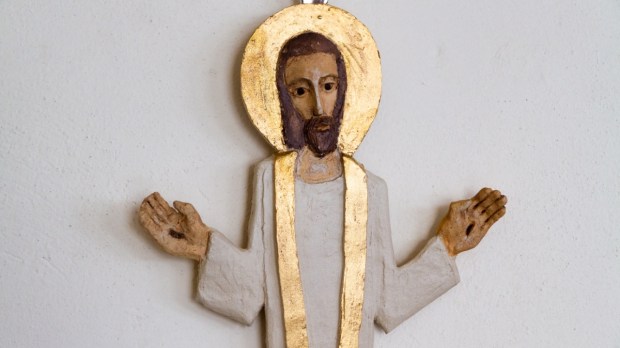A piece of art outside a theologian’s door at Benedictine College makes an incredible point, one that I keep coming back to. It shows a pierced hand reaching out in creation, like God’s hand in Michelangelo’s Sistine Chapel.
The point? “Jesus Christ is the same yesterday, today and forever” and “through him, all things were made.” His pierced hands remain wounded at his resurrection and his Paschal Sacrifice is echoed in the things he made.
That means that when we look at the events of the past, we are not just seeing events that led up to Christ’s sacrifice on the cross; we are seeing events that receive their meaning and power from Christ’s sacrifice on the cross.
Like an echo coming before a shout, you can see God’s saving act bubbling up in time throughout Salvation history.
A Greek Orthodox student of mine at Benedictine College brought a special service to my attention from her Church: The 15 prophecies of the Resurrection that are read on Holy Saturday. I learned about them from Greek Orthodox priest Father George Dokos’s great summary of them here.
In the very beginning of the Bible, in Genesis 1, it is on the third day that life comes to exist — just as Jesus would rise on the third day.
Later in Genesis, God stops Abraham from sacrificing his son Isaac and offers a covenant of new life instead, like Jesus will one day do.
Then, in Exodus 12, the Israelites ward off the angel of death by sacrificing lambs, a prefigurement of the Lamb of God who will overcome the angel of death once and for all.
These prophecies point not just to the Resurrection, but to the way it is passed on in the sacraments.
Exodus 12, we see baptism prefigured when the Israelites cross the Red Sea. They pass from death to life, from slavery to freedom, and see their pursuers destroyed, like Jesus does for us.
In Joshua 5, we see the Eucharist prefigured when the great successor to Moses leads his people into the promised land. There the manna ceases to feed his people, and instead they look to the “new wheat of the land” — inaugurated by a Christlike figure whom Joshua worships.
The great prophets saw truths so powerful they show up throughout time and space.
Jeremiah confidently predicted a “new covenant.” The covenant with Noah meant an everlasting end to destruction, the covenant with Abraham meant new life for ages after his death, and the covenant with David meant a kingdom with no end. Our “new covenant,” in Christ’s resurrection, will mean even more.
Zephaniah suggests what it might mean. The Lord says to wait for “the day when I arise as a witness,” which is also translated as “The day of my resurrection.” Why? “For my decision is to gather nations” and “to assemble kingdoms.”
Isaiah sees this coming resurrection in the rebirth of life every spring. The Lord’s promise “to comfort all who mourn” points directly to the resurrection, and he ays: “As the earth brings forth its shoots, and as a garden causes what is sown in it to spring up, so the Lord God will cause righteousness and praise to spring up before all the nations.”
But the best prophecies might be the ones in familiar Old Testament stories.
The Greek Orthodox read the entire Book of Jonah on the day before Easter, which speaks of the prophet going “down to Sheol” — the land of the dead — and emerging from the belly of the whale on the third day, to hear God say “Arise!” using the same word Jesus used to raise Jairus’s daughter from the dead.
The prophet Elijah prefigured both the Eucharist and the resurrection in his encounters with the widow of Zarephath and her son. First, he provided the widow with a jar of meal and a jug of oil that replenish themselves to feed the woman. But later, when her son died, Elijah “stretched himself upon the child three times, and cried out to the Lord, “O Lord my God, let this child’s life come into him again,” a sign of Christ’s resurrection.
Finally, Daniel tells the story of Shadrach, Meshach and Abednego who were thrown into the fiery furnace of Nebuchadnezzar only to find that “The fire did not touch them at all and caused them no pain or distress,” and “ They walked around in the midst of the flames, singing hymns to God and blessing the Lord.”
Jesus said: “Search the scriptures … they speak about me.”
And since Jesus reveals the truth about man, they also speak about us — and the joy of Christ’s resurrection that was so great, it leaked backwards and forwards, throughout time.

